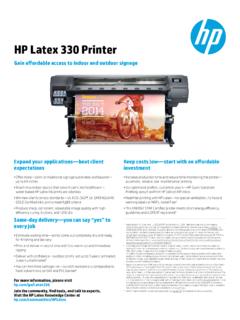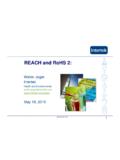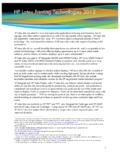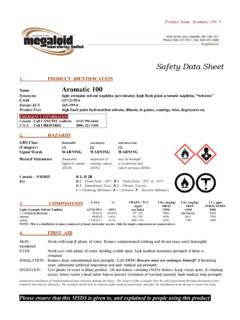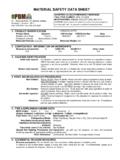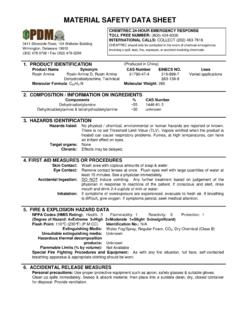Transcription of STEEL BLUE LAYOUT FLUID 1. Identification of the …
1 Safety Data Sheet (91/155/EEC). ITW Dykem Revision date: No.: 2,00. STEEL blue LAYOUT FLUID . 00392-0025. _____. 1. Identification of the substance/preparation and company Commercial product name STEEL blue LAYOUT FLUID . : 80200, 80300, 80400, 80600, 80800, 80900. Use of the substance/preparation Paint Information manufacturer/supplier ITW Dykem 805 E. Old 56 Highway Olathe, KS 66061. Telephone: 001 913 397 9889 Telefax: 001 913 397 8761. 24 Hour Emergency Contact: 001 352 323 3500.. 2. Composition/information on ingredients Chemical characterization : ( preparation ). Preparation in organic solvents Hazardous components (Full text of each relevant R phrase can be found in heading 16). EC No. CAS No. Components Value Symbols R-phrases . 200-661-7 67-63-0 propan-2-ol <5% F, Xi R11-36-67. 203-686-1 109-60-4 propyl acetate <5% F, Xi R11-36-66-67.
2 204-658-1 123-86-4 n-butyl acetate 20 - 30 % R10-66-67. 200-578-6 64-17-5 ethanol 30 - 50 % F R11. 200-751-6 71-36-3 butan-1-ol < 20 % Xn, Xi R10-22-37/38. 41-67.. 3. Hazards Identification Symbols : Highly flammable, Irritant R-phrases : Highly flammable. Risk of serious damage to eyes. Repeated exposure may cause skin dryness or cracking. Vapours may cause drowsiness and dizziness.. 4. First aid measures General information Remove contaminated soaked clothing immediately. If you feel unwell, seek medical advice. After inhalation Move to fresh air in case of accidental inhalation of vapours. Consult a physician. If patient is not breathing, apply artificial respiration. GB_e Page 1 of 7. Safety Data Sheet (91/155/EEC). ITW Dykem Revision date: No.: 2,00. STEEL blue LAYOUT FLUID . 00392-0025. _____. After contact with skin Wash off immediately with soap and plenty of water.
3 Consult a doctor if skin irritation persists. After contact with eyes Rinse immediately with plenty of water, also under the eyelids, for at least 15 minutes. Seek medical treatment by eye specialist. After ingestion Do not induce vomiting. Summon a doctor Never give anything by mouth to an unconscious person. If a person vomits when lying on his back, turn over on his side.. 5. Fire-fighting measures Suitable extinguishing media Alcohol-resistant foam, dry chemical, carbon dioxide (CO2), water-spray Extinguishing media that must not be used for safety reasons Full water jet Special exposure hazards arising from the substance or preparation itself, combustion products, resulting gases Fire may produce: Carbon monoxide and carbon dioxide. Special protective equipment for firefighters Wear self-contained breathing apparatus and protective suit.
4 Additional information Vapours are heavier than air and spread along ground. The vapour/air mixture is explosive, even in empty, uncleaned receptacles. Cool containers at risk with water spray jet. Collect contaminated firefighting water separately, must not be discharged into the drains.. 6. Accidental release measures Personal precautions In case of vapour formation use respirator. Use only explosion-proof equipment. Ensure adequate ventilation. Remove persons to safety. Use personal protective clothing. Environmental precautions Do not discharge into the drains/surface waters/groundwater. Methods for cleaning up/taking up Soak up with inert absorbent material ( sand, silica gel, acid binder, universal binder). Shovel into suitable container for disposal. Additional information Clean contaminated surface thoroughly.. GB_e Page 2 of 7.
5 Safety Data Sheet (91/155/EEC). ITW Dykem Revision date: No.: 2,00. STEEL blue LAYOUT FLUID . 00392-0025. _____. 7. Handling and storage Handling Advice on safe handling Keep container tightly closed. Vapours are heavier than air and spread along ground. Avoid contact with the skin and the eyes. Use only in thoroughly ventilated areas. Advice on protection against fire and explosion Keep away from heat and sources of ignition. Do not smoke. Take precautionary measures against static discharges. Storage Requirements for storage rooms and vessels Keep container tightly closed in a dry, cool and well-ventilated place. Pay attention to anti-explosion rules. Advice on storage compatibility Incompatible with: strong oxidizing agents, reducing agents, acids and bases Further information on storage conditions Keep away from food, drink and animal feeding stuffs.
6 Storageclass (VCI): 3 A.. 8. Exposure controls/personal protection Exposure limit values Exposure limits (EH40). Components Exposure limit CAS No. ml/m mg/m F/ml Category Origin . Propan-2-ol 67-63-0 400 999 TWA (8 h) OES. 500 1250 STEL (15 min) OES. n-Propyl acetate 109-60-4 200 849 TWA (8 h) OES. 250 1060 STEL (15 min) OES. Butyl acetate 123-86-4 150 724 TWA (8 h) OES. 200 966 STEL (15 min) OES. Ethanol 64-17-5 1000 1920 TWA (8 h) OES. - - STEL (15 min) OES. Butan-1-ol 71-36-3 - - TWA (8 h) OES. 50 154 STEL (15 min) OES. GB_e Page 3 of 7. Safety Data Sheet (91/155/EEC). ITW Dykem Revision date: No.: 2,00. STEEL blue LAYOUT FLUID . 00392-0025. _____. Exposure controls Occupational exposure controls Ensure adequate ventilation, especially in confined areas. Protective and hygiene measures Wash hands before breaks and immediately after handling the product.
7 When using, do not eat, drink or smoke. Take off immediately all contaminated clothing. Avoid contact with skin, eyes and clothing. Do not inhale vapours. Respiratory protection In case of insufficient ventilation wear suitable respiratory equipment (gas filter type A). Hand protection Splash protection: Protective gloves resistant to chemicals made off butyl, Minimum coat thickness 0,7 mm, Permeation resistance (wear duration) > 60 minutes, protective glove <Butoject 898> made by This recommendation refers exclusively to the chemical compatibility and the lab test conforming to EN 374. carried out under lab conditions. Requirements can vary as a function of the use. Therefore it is necessary to adhere additionally to the recommendations given by the manufacturer of protective gloves. Eye protection Tightly fitting goggles Eye wash bottle with pure water Body protection Chemical resistant apron Long sleeved clothing.
8 9. Physical and chemical properties Appearance Form: liquid Colour: blue Odour: sweetish Important health, safety and environmental information Test method Changes in the physical state Boiling point: 76 - 125 C. Flash point: 11 C. Ignition temperature: C. Lower Explosion limit: 1,4 vol. %. Upper Explosion limit: 19,0 vol. %. Vapour pressure: hPa (at 20 C). Density: 0,85 g/ml (at 20 C). Water solubility: partially miscible g/l (at 20 C). GB_e Page 4 of 7. Safety Data Sheet (91/155/EEC). ITW Dykem Revision date: No.: 2,00. STEEL blue LAYOUT FLUID . 00392-0025. _____. Vapour density: >1. Solvent content < 95 %. Further information . 10. Stability and reactivity Conditions to avoid Vapours may form explosive mixture with air. Materials to avoid strong oxidizing agents, reducing agents, acids and bases Hazardous decomposition products Carbon monoxide and carbon dioxide Additional information No decomposition if stored and applied as directed.
9 11. Toxicological information Empirical data on effects on humans risk of strong eye injuries Repeated exposure may cause skin dryness or cracking. Vapours may cause drowsiness and dizziness. Additional information Ingestion may cause gastrointestinal irritation, nausea, vomiting and diarrhoea. Effects of breathing high concentrations of vapour may include headache, dizziness, weakness, unconsciousness Repeated or prolonged skin contact may cause skin irritation and/or dermatitis and sensitization of susceptible persons.. 12. Ecological information Additional information Do not flush into surface water or sanitary sewer system. Slightly water hazardous.. 13. Advice on disposal Dispose Where possible recycling is preferred to disposal. Can be incinerated, when in compliance with local regulations. Waste disposal number of Waste from residues / unused product : 080111.
10 WASTES FROM THE MANUFACTURE, FORMULATION, SUPPLY AND USE (MFSU) OF COATINGS. (PAINTS, VARNISHES AND VITREOUS ENAMELS), ADHESIVES, SEALANTS AND PRINTING INKS;. wastes from MFSU and removal of paint and varnish; waste paint and varnish containing organic solvents or other dangerous substances Classified as hazardous waste. GB_e Page 5 of 7. Safety Data Sheet (91/155/EEC). ITW Dykem Revision date: No.: 2,00. STEEL blue LAYOUT FLUID . 00392-0025. _____. Contaminated packaging Empty containers should be taken for local recycling, recovery or waste disposal. Contaminated packaging should be emptied as far as possible and after appropriate cleansing may be taken for reuse. Packaging that cannot be cleaned should be disposed of like the product.. 14. Transport information Land transport (ADR/RID). ADR/RID: 3. Hazard-no.: 33. UN number: 1263.



